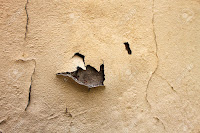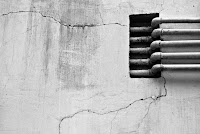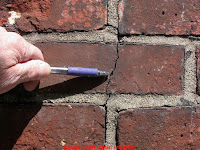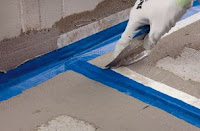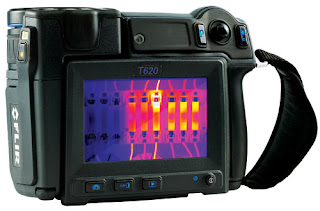External wall seepage is common in few old structures and structures with poor masonry work. The problems could be identified as follows :
1) Dampness or water ingress due to debonding of paint film or deterioration of plaster.
2) Visible or hairline cracks on the vertical masonry surface.

3) Water ingress from external cracks at the joints.

4) Cracks adjoining the window sills.
5) Visible cracks, joints, honey combs, holes, punctures in RCC structure.
6) Cracks in brick or stone cladding.
The above situations are indicative and not exhaustive ; you may come across a similar situation or the deterioration could be even worse.
1) Structural repairs
Concrete columns and foundation walls are load bearing structures ; any major fissure or bulging appearing on this is a sign of poor structural integrity. Such structures should be examined by a qualified professional and a structural audit should be conducted, prior to carrying out any repairs.
Adequate shoring, shuttering and scaffolding should be provided while carrying out structural repairs. If the cracks are due to corrosion or damage to reinforcement within, then they are exposed, treated and filled with repair mortar or microconcrete, as per the requirement.
In repair mortar the water cement ratio higher and hence it is comparatively thicker than concrete, as a result it is used as a bonding element. They are primarily used as binders.
Flowable micro concrete is much thinner when mixed, making it difficult to use as a bonding element. Micro concrete is used in structural repairs and is often reinforced with steel rebar to maintain its structural integrity. It is best used for support, such as beams, walls, or other building foundations.
2) Cracks in masonry walls
The cracks should be exposed by cutting a V shape groove and should be cleaned.
If the cracks are smaller say upto 5 mm wide, acrylic crack filling compounds can be applied to fill the cracks and sealed. If the cracks are wider, non shrinkable crack fillers or epoxy fillers should be used.
3) Damaged plasters
Plastered surfaces may get damaged due to inadequate curing, poor construction practices and extreme weather conditions. Also, if a masonry wall is constructed between two existing RCC columns, cracks may develop at the joints over a period of time, as old and new plasters do not bond.
While replastering, a bonding agent should be used between the old and new plaster surfaces to facilitate bonding.
Besides, the plaster mix should be treated with an additive or integral waterproofing compound to make it cohesive and waterproof.
4) Sealing window sills
Waterproof sealants are used to fill the gap between the window frame and the masonry substrate. However, the sealant should be combatible with both the substrates, i.e., the metal frame and the masonry wall.
For example, if silicon sealant is used between a metal window frame and the substrate made of gypsum boards, it may happen that the sealant becomes too strong for the gypsum layer and may tear it off leading to a crack.
Coatings
Most of the waterproofing compound manufacturers provide a protective coat for the external wall. These coatings range from a thickness of 50 microns to 300 microns and their strengths may vary based upon their technical characteristics.
Waterproof tapes for joints
Waterproofing tapes are available with various manufacturers and can be easily applied to protect the joints. These are usually elastic tapes with alkali resistant fabric for sealing corners in cementitious waterproofing systems.

Nanotechnology compounds
These are primarily water based silane compounds which can be spray applied or with a brush or roller. Upon contact with the substrate, these compounds react at the molecular level and make it hydrophobic.
Ideally these can be applied in external walls as a protective primer or as a finish product on stone or brick cladding.


Infrared Thermography
Infrared Thermography is a method which detects infrared energy emitted from an object, converts it to temperature and displays image of temperature distribution. The image is referred as Infrared thermograph.
The thermographic camera converts radiated heat energy into an electrical signal which is then displayed on a monitor. The camera assigns black colour for the coolest area and white for the hottest area.
These are used in diagnosis of electrical systems, fire protection and in water proofing for detecting moisture content.
Infrared Thermography is a tool for diagnosing and mapping specific areas, which are the source of water ingress.

